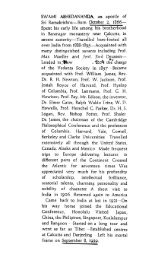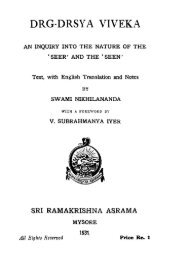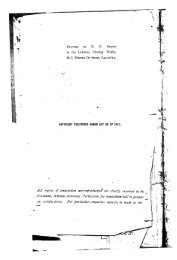<strong>Practical</strong> <strong>Vedanta</strong>It is the journey from truth to truth, from lower truth to higher truth. Darkness isless light; evil is less good; impurity is less purity. It must always be borne inmind that we should see others with eyes of love, with sympathy, knowing thatthey are going along the same path that we have trodden. If you are free, you mustknow that all will be so sooner or later, and if you are free, how can you see theimpermanent? If you are really pure, how do you see the impure? For what iswithin, is without. We cannot see impurity without having it inside ourselves. Thisis one of the practical sides of <strong>Vedanta</strong>, and I hope that we shall all try to carry itinto our lives. Our whole life here is to carry this into practice, but the one greatpoint we gain is that we shall work with satisfaction and contentment, instead ofwith discontent and dissatisfaction, for we know that Truth is within us, we have Itas our birthright, and we have only to manifest It, and make It tangible.<strong>Practical</strong> <strong>Vedanta</strong>Part III(Delivered in London, 17th November 1896)In the Chhâdogya Upanishad we read that a sage called Nârada came to anothercalled Sanatkumâra, and asked him various questions, of which one was, ifreligion was the cause of things as they are. And Sanatkumara leads him, as itwere, step by step, telling him that there is something higher than this earth, andsomething higher than that, and so on, till he comes to Âkâsha, ether. Ether ishigher than light, because in the ether are the sun and the moon, lightning and thestars; in ether we live, and in ether we die. Then the question arises, if there isanything higher than that, and Sanatkumara tells him of Prâna. This Prana,according to the <strong>Vedanta</strong>, is the principle of life. It is like ether, an omnipresentprinciple; and all motion, either in the body or anywhere else, is the work of thisPrana. It is greater than Akasha, and through it everything lives. Prana is in themother, in the father, in the sister, in the teacher, Prana is the knower.I will read another passage, where Shvetaketu asks his father about the Truth, andthe father teaches him different things, and concludes by saying, "That which isthe fine cause in all these things, of It are all these things made. That is the All,that is Truth, thou art That, O Shvetaketu." And then he gives various examples."As a bee, O Shvetaketu, gathers honey from different flowers, and as the differenthoneys do not know that they are from various trees, and from various flowers, soall of us, having come to that Existence, know not that we have done so. Now, thatfile:///C|/Documents%20and%20Settings/Chitra%20Selva...oksBySwami/<strong>Practical</strong><strong>Vedanta</strong>/<strong>Practical</strong><strong>Vedanta</strong>PDF.html (22 of 113)2/26/2007 12:24:33 AM
<strong>Practical</strong> <strong>Vedanta</strong>which is that subtle essence, in It all that exists has its self. It is the True. It is theSelf and thou, O Shvetaketu, are That." He gives another example of the riversrunning down to the ocean. "As the rivers, when they are in the ocean, do notknow that they have been various rivers, even so when we come out of thatExistence, we do not know that we are That. O Shvetaketu, thou art That." So onhe goes with his teachings.Now there are two principles of knowledge. The one principle is that we know byreferring the particular to the general, and the general to the universal; and thesecond is that anything of which the explanation is sought is to be explained so faras possible from its own nature. Taking up the first principle, we see that all ourknowledge really consists of classifications, going higher and higher. Whensomething happens singly, we are, as it were, dissatisfied. When it can be shownthat the same thing happens again and again, we are satisfied and call it law. Whenwe find that one apple falls, we are dissatisfied; but when we find that all applesfall, we call it the law of gravitation and are satisfied. The fact is that from theparticular we deduce the general.When we want to study religion, we should apply this scientific process. The sameprinciple also holds good here, and as a fact we find that that has been the methodall through. In reading these books from which I have been translating to you, theearliest idea that I can trace is this principle of going from the particular to thegeneral. We see how the "bright ones" became merged into one principle; andlikewise in the ideas of the cosmos we find the ancient thinkers going higher andhigher — from the fine elements they go to finer and more embracing elements,and from these particulars they come to one omnipresent ether, and from that eventhey go to an all embracing force, or Prana; and through all this runs the principle,that one is not separate from the others. It is the very ether that exists in the higherform of Prana, or the higher form of Prana concretes, so to say, and becomesether; and that ether becomes still grosser, and so on.The generalization of the Personal God is another case in point. We have seenhow this generalization was reached, and was called the sum total of allconsciousness. But a difficulty arises — it is an incomplete generalization. Wetake up only one side of the facts of nature, the fact of consciousness, and uponthat we generalise, but the other side is left out. So, in the first place it is adefective generalization. There is another insufficiency, and that relates to thesecond principle. Everything should be explained from its own nature. There mayhave been people who thought that every apple that fell to the ground was draggeddown by a ghost, but the explanation is the law of gravitation; and although weknow it is not a perfect explanation, yet it is much better than the other, because itis derived from the nature of the thing itself, while the other posits an extraneouscause. So throughout the whole range of our knowledge; the explanation which isbased upon the nature of the thing itself is a scientific explanation, and anexplanation which brings in an outside agent is unscientific.So the explanation of a Personal God as the creator of the universe has to standfile:///C|/Documents%20and%20Settings/Chitra%20Selva...oksBySwami/<strong>Practical</strong><strong>Vedanta</strong>/<strong>Practical</strong><strong>Vedanta</strong>PDF.html (23 of 113)2/26/2007 12:24:33 AM
- Page 1 and 2: Practical VedantaPractical VedantaP
- Page 3 and 4: Practical Vedantaworld. If I am a s
- Page 5 and 6: Practical Vedantadifference is only
- Page 7 and 8: Practical VedantaThe ideal of faith
- Page 9 and 10: Practical Vedantamoment of our live
- Page 11 and 12: Practical Vedantaof the Christs and
- Page 13 and 14: Practical Vedanta"This life is Brah
- Page 15 and 16: Practical Vedantadark fifteen days,
- Page 17 and 18: Practical Vedantalife. This is the
- Page 19 and 20: Practical Vedantaeverything would b
- Page 21: Practical Vedantait is only through
- Page 25 and 26: Practical Vedantanoumenon and pheno
- Page 27 and 28: Practical Vedantato which is the be
- Page 29 and 30: Practical VedantaAbsolute.The finit
- Page 31 and 32: Practical Vedantawhich is not the q
- Page 33 and 34: Practical Vedantaexperience that th
- Page 35 and 36: Practical Vedantafulfilled. The Jiv
- Page 37 and 38: Practical Vedantabetween the pure r
- Page 39 and 40: Practical Vedantacome out straight.
- Page 41 and 42: Practical Vedantawar with one anoth
- Page 43 and 44: Practical Vedantanobody could under
- Page 45 and 46: Practical VedantaMy idea, therefore
- Page 47 and 48: Practical Vedantathe same methods.
- Page 49 and 50: Practical Vedantavarious minds, all
- Page 51 and 52: Practical Vedantabrotherhood; but t
- Page 53 and 54: Practical Vedantabrotherhood, but w
- Page 55 and 56: Practical Vedantawe all go with ves
- Page 57 and 58: Practical Vedantareason. What can y
- Page 59 and 60: Practical Vedantabeen preached in t
- Page 61 and 62: Practical Vedantathe husband kisses
- Page 63 and 64: Practical Vedantaof the knowledge a
- Page 65 and 66: Practical Vedantafor those who only
- Page 67 and 68: Practical Vedantasun exists because
- Page 69 and 70: Practical Vedantaof death was pleas
- Page 71 and 72: Practical VedantaGod. We must learn
- Page 73 and 74:
Practical Vedantaa plague comes, it
- Page 75 and 76:
Practical VedantaAtman? "As with a
- Page 77 and 78:
Practical Vedantathat immortal One,
- Page 79 and 80:
Practical Vedantaand the third egoi
- Page 81 and 82:
Practical VedantaWitness of the uni
- Page 83 and 84:
Practical VedantaPractical Vedanta1
- Page 85 and 86:
Practical Vedantaeternal ; every ot
- Page 87 and 88:
Practical Vedantafaculty, Buddhi, w
- Page 89 and 90:
Practical VedantaPractical Vedanta1
- Page 91 and 92:
Practical Vedantastepping-stone to
- Page 93 and 94:
Practical Vedantarecognition? Findi
- Page 95 and 96:
Practical Vedantasentient." This is
- Page 97 and 98:
Practical Vedantaessentially differ
- Page 99 and 100:
Practical Vedantaexistence is limit
- Page 101 and 102:
Practical Vedantalive, for I am lif
- Page 103 and 104:
Practical Vedantasee from Kapila's
- Page 105 and 106:
Practical Vedantalimitation, but th
- Page 107 and 108:
Practical Vedantaperfect, infinite,
- Page 109 and 110:
Practical Vedantaindividuality, of
- Page 111 and 112:
Practical Vedantarepeat [something]
- Page 113:
Practical Vedantaperson who dies in
















